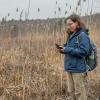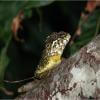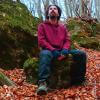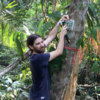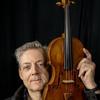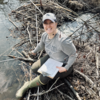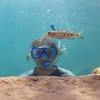Acoustic sensors enable efficient and non-invasive monitoring of a wide range of species, including many that are difficult to monitor in other ways. Although they were initially limited in application scope largely due to cost and hardware constraints, the development of low-cost, open-source models like the Audiomoth in recent years has increased access immensely and opened up new avenues of research. For example, some teams are using them to identify illicit human activities through the detection of associated sounds, like gunshots, vehicles, or chainsaws (e.g. OpenEars).
With this relatively novel dimension of wildlife monitoring rapidly advancing in both marine and terrestrial systems, it is crucial that we identify and share information about the utility and constraints of these sensors to inform efforts. A recent study identified advancements in hardware and machine learning applications, as well as early development of acoustic biodiversity indicators, as factors facilitating progress in the field. In terms of limitations, the authors highlight insufficient reference sound libraries, a lack of open-source audio processing tools, and a need for standardization of survey and analysis protocols. They also stress the importance of collaboration in moving forward, which is precisely what this group will aim to facilitate.
If you're new to acoustic monitoring and want to get up to speed on the basics, check out these beginner's resources and conversations from across the WILDLABS platform:
Three Resources for Beginners:
- Listening to Nature: The Emerging Field of Bioacoustics, Adam Welz
- Ecoacoustics and Biodiversity Monitoring, RSEC Journal
- Monitoring Ecosystems through Sound: The Present and Future of Passive Acoustics, Ella Browning and Rory Gibb
Three Forum Threads for Beginners:
- AudioMoth user guide | Tessa Rhinehart
- Audiomoth and Natterjack Monitoring (UK) | Stuart Newson
- Help with analysing bat recordings from Audiomoth | Carlos Abrahams
Three Tutorials for Beginners:
- "How do I perform automated recordings of bird assemblages?" | Carlos Abrahams, Tech Tutors
- "How do I scale up acoustic surveys with Audiomoths and automated processing?" | Tessa Rhinehart, Tech Tutors
- Acoustic Monitoring | David Watson, Ruby Lee, Andy Hill, and Dimitri Ponirakis, Virtual Meetups
Want to know more about acoustic monitoring and learn from experts in the WILDLABS community? Jump into the discussion in our Acoustic Monitoring group!
Header image: Carly Batist
No showcases have been added to this group yet.
- 0 Resources
- 2 Discussions
- 2 Groups
Recently accepted into the Rangeland, Wildlife and Fisheries graduate program at Texas A&M.
- 0 Resources
- 0 Discussions
- 1 Groups
- @fsanger
- | she / her/ ella
- 0 Resources
- 5 Discussions
- 7 Groups

- 0 Resources
- 0 Discussions
- 2 Groups
- @foxy50213
- | Mr.
- 0 Resources
- 0 Discussions
- 8 Groups
- 0 Resources
- 0 Discussions
- 4 Groups
- 0 Resources
- 3 Discussions
- 2 Groups
Founder & CEO of we.are.tohorā, creating a community that cares about whales, the environment and each other.
- 0 Resources
- 0 Discussions
- 13 Groups
- @bumbleben
- | He/Him
Junior dev in a bioacoustics startup, interested in all forms of remote sensing and biologging
- 0 Resources
- 0 Discussions
- 4 Groups
IBM
Software Engineer for last 20 years and running a conservation organization for last 3 years, looking for more opportunities to implement tech skills for conservation
- 0 Resources
- 0 Discussions
- 1 Groups
- 0 Resources
- 0 Discussions
- 5 Groups
- @Thomas_Luypaert
- | He/him
Norwegian University of Life Sciences (NMBU)
Ecological monitoring enthusiast with a focus on ecological and conservation research
- 1 Resources
- 1 Discussions
- 7 Groups
Ol Pejeta Conservancy partners with conservation and technology organisations to kick-start a research and innovation centre for wildlife conservation
31 May 2019
In February, we released an open call for the WILDLABS TECH HUB, offering 3 months of support for solutions using technolgy to tackle the illegal wildlife trade. We were overwhelmed by an incredible 37 submissions,...
13 May 2019
Happy World Wildlife Day! To celebrate, this week we've asked our community to share photos showing how they are using tech in the field or the lab, using the #Tech4Wildlife hashtag.
3 March 2019
In this case study, Science Reporter Jamie Morton tells the story of how Kiwi scientists are teaming up with a local underwater robotics company to gain world-first insights into the lives of whales in Antarctica.
4 February 2019
As human impacts on the world accelerate, so does the need for tools to monitor the effects we have on species and ecosystems. In this article, Ella Browning and Rory Gibb share insights from their recent review paper...
4 December 2018
Article
In this case study, conservation ecologist Ayesha Tulloch takes us behind the scenes of her recent paper, which came out in Nature Ecology & Evolution earlier this month. In this paper, Ayesha and her team present a...
20 August 2018
Last month, the 2018 Ecoacoustics Congress was held in Brisbane. Bringing together scientists, natural resource managers, industry and artists, participants explored the ways that sound can deepen our understanding of...
25 July 2018
This latest chapter in the Conservation Technology Series from WWF-UK looks at the opportunities, challenges and state-of-the-art of satellite remote sensing for conservation applications. This issue reviews available...
23 April 2018
Hundreds of people joined our #Tech4Wildlife photo challenge this year, showcasing all the incredible ways tech is being used to support wildlife conservation. We've seen proximity loggers on Tasmanian Devils in...
3 March 2018
Our panel of international experts has been hard at work reviewing the 47 proposals we recieved for innovative technological tools to address human wildlife conflict. The panelists have systematically been assessing the...
20 October 2017
The inherent complexity of not only deploying technologies in the field but also doing so in a scientifically rigorous manner can prove a substantial barrier for the effective use of conservation technologies, and clear...
11 October 2017
Its been a busy couple of months for the Open Acoustic Devices team. They've just returned back from Belize where they have been trialling the new AudioMoth design for gunshot detection. Find out what they've been up to...
27 June 2017
August 2025
event
September 2025
event
October 2025
November 2025
event
September 2022
August 2022
July 2022
64 Products
Recently updated products
| Description | Activity | Replies | Groups | Updated |
|---|---|---|---|---|
| Yeah that would be great - I have done a little looking into it today and I have some ideas. I'd love to collab. I will DM you |
+16
|
Acoustics | 1 year ago | |
| Many thanks. That is a useful place to start. I don't think there is any shortage of blackbirds in the UK. And they nest in our garden every year. I don't remember the last time I... |
|
Acoustics | 1 year 1 month ago | |
| Hi Luke,As Matthew has suggested, the best way is always to run a test run whenever you are doing something new. Put your recorders out for one or two days and see how they... |
|
Acoustics | 1 year 1 month ago | |
| My organization has some Wildlife Acoustics SongMeter SM4 units that we’re looking to sell. We need more mobile and cost-effective ARUs for... |
|
Acoustics | 1 year 1 month ago | |
| Hi Chris - I missed this entire dialog, just to say I have successfully recorded all the"quiet" bats using pippyg / pippistrelle, but it inevitably turns into an SNR issue, and... |
|
Acoustics | 1 year 1 month ago | |
| Fantastic!! |
|
Acoustics, AI for Conservation, Animal Movement, Build Your Own Data Logger Community, Community Base, Early Career, Ethics of Conservation Tech, Marine Conservation, Open Source Solutions | 1 year 2 months ago | |
| If you search Digikey for a 'strain relief' you should be able to find a rubber grommet that will hold that mic without any additional machining. A blob of silicone will adhesive... |
|
Acoustics | 1 year 2 months ago | |
| Thanks Carly! I had reviewed some of the help files, but clearly not the right ones!My email is deanc5697@my.uwstout.edu |
|
Acoustics, Software Development | 1 year 2 months ago | |
| Hi Tabitha, What recording settings were you using when you saw these differences? I've measured the consumption across some different firmware versions and I can't see any... |
+10
|
Acoustics | 1 year 2 months ago | |
| Hello!Long time, no update. @StephODonnell suggested I post here with my thesis and some reflections. ---------------------------------------------------------TL;DR... |
+19
|
Acoustics | 1 year 3 months ago | |
| Hi Jesse,For a material to be acoustically transparent (in air), the speed of sound in the material times its density must match that of air. Realistically, any solid... |
+1
|
Acoustics, Animal Movement | 1 year 3 months ago | |
| Hi Steph, We appreciate the support! Thanks for the tag and your help managing the community!Patrick |
|
Sensors, Acoustics, Conservation Dogs, Emerging Tech, Open Source Solutions | 1 year 3 months ago |



